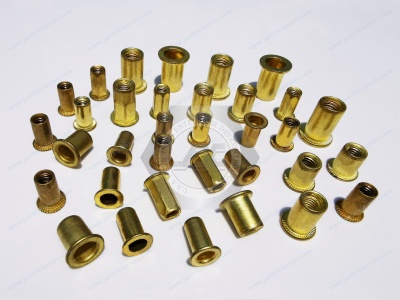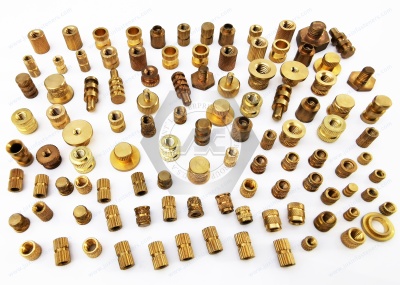Call Us
+86 136 6007 9809
Call Us
+86 136 6007 9809
Jan. 15, 2024
Brass nut characteristics and selection of industry solutions
The brass nut uses brass material (generally lead brass, such as H59 and H62) and is made of nuts. Our daily contact with the brass nut is mainly hexagonal nuts or bolts with other brass nuts. Brass nuts are not easy to rust, corrosion, conductive and conductive, and other advantages generally used for rust, high temperature, conductive, conductive, and further use of the environment, such as faucets, valves, electrical switches, and so on. The brass nut is a commonly used fastener characterized by brass material formed after many processing times. It has good corrosion resistance, tensile strength, UV resistance, and other characteristics, so brass nuts in building decoration, furniture decoration, and other aspects have a wide range of applications. A brass nut is a commonly used fastener for connecting threaded parts. It is made of brass material with good electrical conductivity, thermal conductivity, and corrosion resistance. The standard for brass nuts is to regulate their appearance size, quality requirements, technical conditions, and so on to ensure their quality and reliability.
Characteristics of brass nuts
1. Corrosion resistance: the surface of the brass nut is galvanized, which has good corrosion resistance and can effectively prevent the erosion of the nut by acids, alkalis, and corrosive agents.
2. Tensile strength: brass nuts have good tensile strength and can effectively withstand the tensile force of the fasteners so that the fasteners are firmly fixed on the object.
3. UV resistance: the surface of copper nuts is galvanized, which has good UV resistance and can effectively prevent the corrosion of the nuts by ultraviolet rays.
How do you choose high-quality copper nuts?
1. Material: When choosing brass nuts, you should select nuts made of copper alloy, which has good tensile strength and corrosion resistance and can better ensure the service life of the nuts.
2. Surface treatment: the surface treatment of brass nuts is generally based on galvanized treatment; galvanized treatment can effectively prevent corrosive agents, ultraviolet rays, etc., on the erosion of the nut to better ensure the service life of the nut.
3. Size: When choosing brass nuts, attention should be paid to selecting the appropriate size to ensure the nut can better match the fastener and its stability.


What are the standards for brass nuts?
1. ISO standards: The International Organization for Standardization (ISO) has issued a series of standards for brass nuts, including ISO 4035:1999 "Hexagon regular nuts (style 1) - Product grades A and B", ISO 4032:1999 "Hexagon regular nuts (style 2) - Product grades A and B" and ISO 7040:1983 "Hexagon regular nuts with thermal resistance." Regular nuts (style 2) - Product grades A and B", ISO 4032:1999 "Hexagon regular nuts (style 2) - Product grades A and B" and ISO 7040:1983 "Hexagon regular nuts with thermal resistance
classification 10 and 20", etc. These standards specify thread types, dimensions, materials, mechanical properties, etc. 2.
2. DIN standards: The German Institute for Standardization (DIN) has issued several standards for brass nuts, such as DIN 934 "Hexagon nuts" and DIN 6923 "Hexagon flange nuts." These standards specify the appearance of brass nuts, thread specifications, material requirements, and other content, as well as the performance of the test method requirements.
3. ANSI standards: The American National Standards Institute (ANSI) has issued several standards for brass nuts, including ANSI B18.2.2, "American National Standard for Square and Hex Nuts" and ANSI B18.6.3 "American National Standard for Machine Screw Nuts," among others. These standards specify brass nuts' size, shape, material, and performance requirements.
4. JIS Standards: The Japanese Institute of Industrial Standardization (JIS) has issued several standards for brass nuts, such as JIS B1181, "Hexagon nuts," and JIS B1190, "Round nuts." These standards regulate the appearance of brass nuts in terms of dimensions, materials, and thread requirements.
When using brass nuts, the appropriate nut should be selected according to the applicable standard and installed and used according to the standard requirements. At the same time, attention should be paid to keeping the nuts and connecting parts clean, and proper torque should be observed when tightening to avoid damage or loosening of the nuts. In addition, regularly check the status of the nut and replace it as needed to ensure the reliability of the connection.
In conclusion, brass nuts have good corrosion resistance, tensile strength, and UV resistance, so they have a wide range of applications in building decoration, furniture decoration, etc. When choosing brass nuts, attention should be paid to selecting nuts made of brass alloy, and the surface should be galvanized to ensure the quality and service life of the nuts. At the same time, attention should also be paid to choosing the right size to ensure the stability of the fasteners.
Please contact me if you want high-quality brass nuts fasteners or technical support for structural design. Thanks.Email:adelajonly@gmail.com
Website: https://www.juxinfasteners.com
Contact Us
Tel.:
+86 020 8621 0320
+86 020 3121 6067
Technical Support:
Navigation
SEND INQUIREY